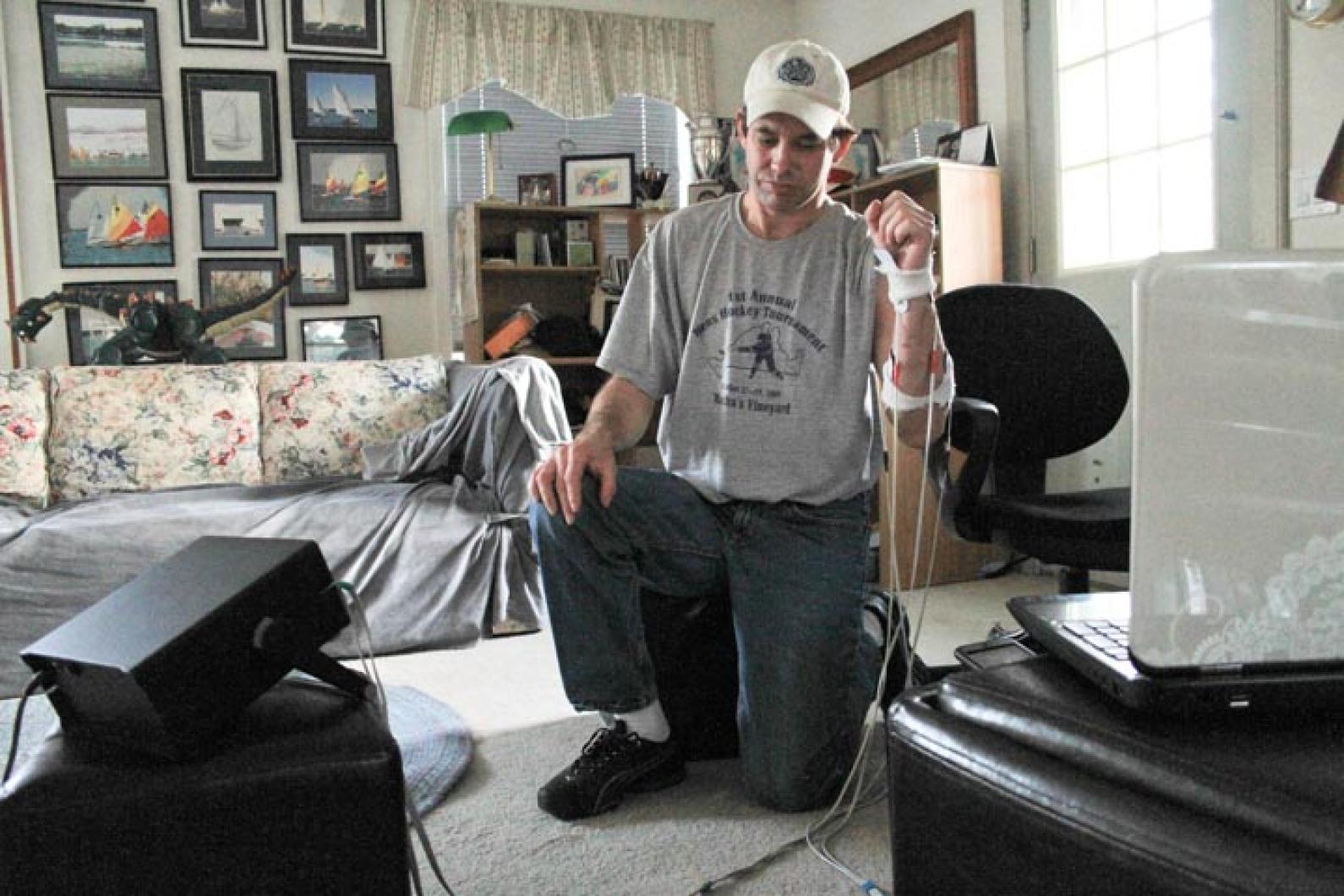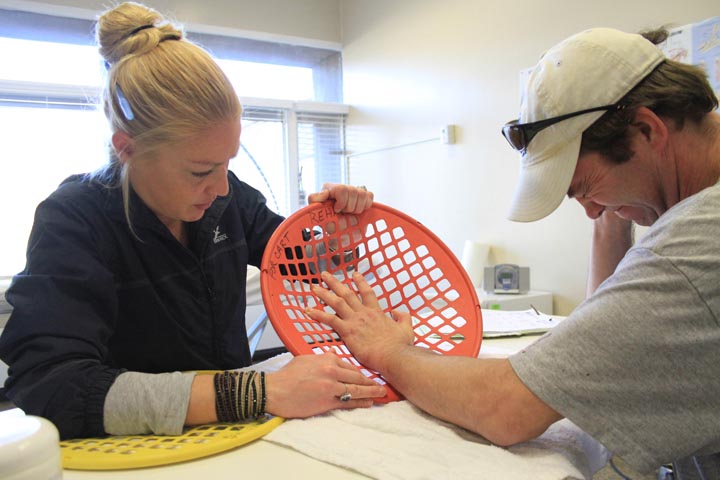In 1992, Charlie Shipway took to the waters of the Mediterranean Sea, sailing in the Barcelona Olympic games as a representative of the U.S. Virgin Islands. The competition was world-class; the stakes raised to a near-peak. Mr. Shipway and catamaran captain Jean Brauer placed 22nd in the 22-boat field—somebody has to, after all.
These days, stakes remain high, but there will be no placing last. Mr. Shipway’s only competitor is his own body, as he pushes to recover from a bone-shifting hockey injury. He’ll accept nothing less than complete success.
And with the help of physical therapy, a grocery list of over-the-counter remedies, and a deus ex machina in the form of Boston Bruins goalie Tim Thomas, he’s on his way.
“I want to be 99 per cent,” Mr. Shipway, 43, said in a Gazette interview in his Chilmark home (a longtime summer resident, he moved permanently to Martha’s Vineyard shortly before competing in the Olympics, and shortly before daughter, Kira, last year’s regional high school class essayist, was born). “I want to be able to not be limited when I teach sailing and do carpentry . . . I want to be able to pick up my son [Tyler, age 7], you know?”
He’d just fired a puck toward goalie Paul van Landingham during a senior league game on Oct. 6 at the Martha’s Vineyard Arena; the puck didn’t go in, but the momentum from skating toward the net carried Mr. Shipway past the goal, where he tripped and went airborne, slamming into the boards and crushing his left arm between the fiberglass plates and his body. His forearm was swathed in a padded glove, a good cushion when falling on the ice, but not when dealing with the laws of inertia. Both the radius and ulna shattered. He points to a dark line of scar tissue on his forearm where the bone came through the skin.
The senior hockey league is competitive, but intended for the recreational player. There is no checking and players “all want to go to work the next day,” said Mr. Shipway. “You have to be careful of each other, because we all have families and we all need to work.
“I have two rules — don’t hurt anyone else, and don’t hurt yourself,” he said. And then, in a quieter, sheepish tone, “. . . I broke one of them.”
He continued: “This is what I thought [when I was lying on the ice]. ‘I’ve let down my family, my wife and my kids, my boss, myself . . .’ ”
But after this moment of panic, after the surgery to reset his bones—he now has a metal plate inside his forearm holding everything together — Mr. Shipway set his focus on saving his atrophying arm. “That’s the thing that really got me [motivated],” he said, glancing down at the arm. “It’s falling apart; it’s dying. I’m losing everything that I worked 43 years to get to, and I don’t want to wait a long time. I want to start working on it now, as soon as I can.”
Standing in the way of any sort of recovery, however, was a chronic, pulsing, angry pain of the sort that’s impossible to describe using the standard one-to-ten scale. Mr. Shipway’s hand was, as he described it, “burning up, numb, hypersensitive—it was a whole bunch of opposites all together.” The medication he’d been prescribed did nothing to alleviate the persistent agony in his reconstructed arm.
Intervention came in the form of a public access television spot hosted by Tim Thomas, who was about to open a clinic in Danvers for use of the ARPwave machine, a device that uses bio-electric current to repair damaged neurological connections and stimulate blood flow. Mr. Thomas credited the ARPwave with speeding his recovery from hip surgery in 2010.
“I see Tim Thomas on TV in his little channel seven [spot],” recalled Mr. Shipway. “And he says ‘If you’re in pain, and you just had surgery, you should come to the Tim Thomas ARP clinic. We can help you. We have a grand opening on the 23rd.’
“That was a no-brainer,” Mr. Shipway said. “I said, well, those are the two words that are a big part of my life right now: pain and surgery.”
Following his own surgery and recovery, Mr. Thomas had his best season yet, breaking the NHL save percentage record, winning the Conn Smythe and Vezina trophies, and bringing the Stanley Cup to Boston. “You can’t perform at that level unless you had some help, that’s what I was thinking,” said Mr. Shipway. Eager to try anything to make the pain go away, he and friend Jeff Dunn attended the clinic’s grand opening.
Whatever Mr. Shipway expected from the clinic, it certainly wasn’t instant relief. His face breaks into an enormous grin and his tone takes on a ring of incredulity when he recounts how, on being hooked up to ARPwave, the pain vanished — ”evaporated out of nowhere,” Mr. Shipway said —and he raised his arm above his head for the first time since the accident.
The results made an impression even upon the founder of the ARPwave program, Denis Thompson.
“Unbelievable,” he said in a Skype interview with the Gazette. “He was elated.”
And the pain stayed away for two days afterwards, Mr. Shipway said. He returned home that night and attended the Beatlesmania concert with wife, Sarah, and Tyler. “I was happy as a clam,” he said.
The device seemed perfectly aligned with Mr. Shipway’s goal of speedy recovery, and he enrolled in the trial program, which connected him with both a machine of his own and a therapist he consults with via Skype while using the ARPwave. “When I looked at my injury, I said, okay, if I want to get better faster, I have to look outside the box,” said Mr. Shipway. “I have to do everything I can on all levels.”
In his living room is a box filled with various creams and gels; when Mr. Shipway lists them off, it sounds a bit like a medical version of the Johnny Cash song I’ve Been Everywhere: “I’ve got sciatica rx . . . I’ve got muscle rescue . . . arthritis gel . . . comfrey . . . a book this thick on Chinese medicine . . .
“But there was nothing that could get rid of the pain like the ARPwave did,” he said.
Six weeks after the accident, Mr. Shipway received confirmation that his out-of-the-box healing regimen was yielding results: His bones had healed enough at the sites of the break that he not only could begin physical therapy two weeks ahead of schedule, but he could also go back to his carpentry job. “My hand’s getting strong,” he said, “Really strong.”
During a physical therapy session at the hospital last week, Mr. Shipway worked with Lauren Weaver through 45 minutes of flexibility and range-of-motion exercises (when Mr. Shipway first started PT 20 days ago, his left wrist had only 10 degrees of extension, compared to the normal 70 degrees.
The session resembled slow-motion arm wrestling, as Dr. Weaver worked to stretch out the still-tightened ligaments and tendons. Mr. Shipway drew on meditation exercises learned while training for the Olympics to relax while his muscles were pulled out of their comfort zone.
This kind of discomfort, however, pales in comparison to the nightmare pain from six weeks ago.
“I love it, actually,” said Mr. Shipway. “It’s progress.”





Comments (3)
Comments
Comment policy »